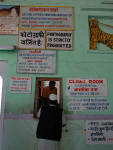Many Indians claim that the Dilwara Jain temples of Mt. Abu are a more magnificient achievement than the Taj Mahal - both were stunningly ambitious, state-sponsored, multi-year, monumental, marble-work projects - but the claim seems imponderable to me. One difference, however, springs to mind: while thousands of art lovers and devotees also worked for a generation on each of the two Dilwara temples, the Taj, proof of an emperor's inability to rationally accept his lover's death, was built largely by hired men. I can understand a man's desire for a memorial to his lover; I also believe that a modest memorial need not be any less meaningful, but no, size clearly mattered to Shah Jehan. He had to divert enormous resources of state to fund his absurd private infatuation.
While I think the
Taj is rather sublime -
I am awed by its beauty each time I visit - the so-called "romance of its inspiration"
bugs me. For the untold thousands who labored on it,
Shah Jehan didn't
even have the magnanimity to dedicate the Taj to, say,
"all the
lovers of Hindustan," or something similarly
inclusive. The poet Sahir Ludhianvi, speaking for the masses,
famously
said of the Taj:
"Ik
shahanshah ney daulat ka sahaara ley kar / Ham ghareebon
kee mohabbat ka uraaya hai mazaaq"
(An emperor relying so
on his wealth / Has ridiculed the loves of the poor like
us).
On the other hand, the Dilwara temples, built half a
millennium before the Taj, seem to me expressions of a
fairly democratic religiosity.
The temples lie a few miles from Mt. Abu, a picturesque hill resort centered on Nakki lake, atop an isolated feature of the Aravali Range in southern Rajasthan. Mt. Abu was once the HQ of the British Rajputana States Agency. If you read Hindi, check out the local rendition at a traffic square of the famous lines from Frost's Stopping by Woods on a Snowy Evening.
The two main temples at Dilwara, built in the northern Nagara style (as opposed to the southern Dravidian style), are the Vimala Vasahi temple (1031 CE) and Tejpal temple (1200 CE), known for the audacity and the delicacy of their rich marble-work. Unlike most other Indian temples, their exterior is starkly plain; it is the interior that is far more magnificent, especially the breathtaking chandelier-like marble ceilings and ornately carved brackets and pillars. The two temples were commissioned by the Solankis of Gujarat (a branch of the Chalukyas of southern and western India) and one of their former feudatories, the Vaghelas, respectively.
Sadly, photography at this exquisite global cultural heritage site was banned in 1992 for reasons that no one at the temples is willing to articulate clearly (why not allow it for a fee during a designated visiting hour at the least ? ). Orders, say the orderlies, issue from a managing trust, one that seems to me dominated by conservative and obscurantist Jain elders who, in their infinite and timeless wisdom, also deem it proper to bar menstruating women from entering the temple precincts (enforcing this is fortunately not easy - I looked around but saw no sniffer dogs ;-). [- Apr 06. Leave a comment here.]
 |
 |
Evening on the lake  |
Another view  |
Toad rock (more)  |
Nakki lake (daytime)  |
||
Hiking the Aravali range  |
Nakki lake (evening)  |
||
Outside Dilwara temples  |
Robert Frost poem in Hindi  |
Local woman |
Local mother and child  |
Construction laborers  |
"God Juice" soft drink  |
||
Construction laborers  |
Cave wall with lichen  |
||
Hiking near Mt. Abu (more)  |
Hikers  |
Rough descent  |
Steep drop to the plains  |
|
Dilwara Temples (The photos below are sold at stalls outside the temples. Shunya.net does not own the copyright to these images) |
|||
 |
 |
 |
 |
 |
 |
 |
 |
 |
 |
 |
 |
Designed in collaboration with Vitalect, Inc. All rights reserved. |









